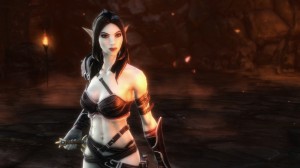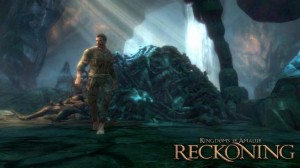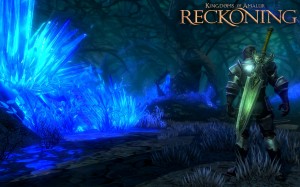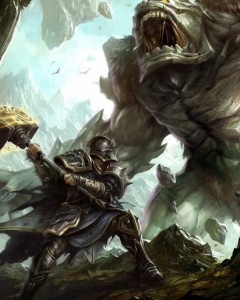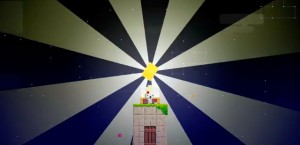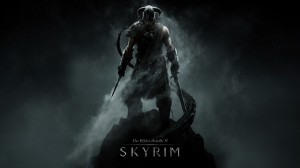Overview:
So, you think you can save the mortal races of Amalur, do you? Lucky for you, you just died and some very pioneering gnome has decided to bring you back. The world of Amalur revolves around fate, and it would seem the immortal Winter Fae have become aggressive under a new King’s rule. Humanity, who, until now, lived in general harmony with the Fae have had to defend themselves against this foe with ever waning success. Fate seems to have deemed mortal-kind become extinct until your character happens to die and come back to life with no written fate. The fact that you have no fate may seem trivial, but the devil’s in the details as they say. In the game, everyone you interact with has their fate altered in unexpected ways. People you kill, who weren’t supposed to die, can’t do anything they were supposed to do and Fate’s plan is effectively dismembered.
So, in a nutshell, you play the avatar of Chaos in a world with an exceptional graphic art style, great story, and excellent sound. Less than impressive items were the interface, camera, immersion, and character customization; the last two being the most disappointing of all. Read the full review for more details. (see below)
Full Review:
As the game starts we get introduced into a world entirely separate from our own, but one that shares a lot of key sentiments. Yes, Amalur is a realm of magic and traditional fantasy based races such as elves and the Fae, so where are the similarities? Well, like every world, there are some laws that are just understood to be unalterable. Like the fact that gravity exists, or that we all die eventually. Big whoop, right?
Take a second and imagine a scenario for me: someone you trust implicitly tells you they found someone who could break the laws of physics at will. I would guess quite a few thoughts run through your head including Chris Angel and his magical special effects budget. What should really get you though is the “oh crap” moment when you realize everything everyone took for granted and accepted as fact just isn’t reliable anymore. This is the feeling that animates the NPCs of this game. That floor your standing on? Nope, not solid, sorry. So, immediately, from the start of the game, you have to realize that your character is being viewed simultaneously as the most fantastic and dangerous person in the world by everyone you meet who’s heard of your title, “The Fateless One”. You are the only person in the world of Amalur who can change fate, and not just your own. Think about it for a second, everyone’s fate is intertwined with everyone else’s at some level. If fate deemed you died tomorrow, then everyone else’s fate wouldn’t have you tangled up in it. Well, if you didn’t, then everyone’s fate starts unraveling. You, as our great hero in Amalur, just broke the fundamental law of civilization. I know, I know, you haven’t even picked up the controller yet. This is a lot of weight to lay on a gamer’s shoulders. Don’t worry though, not everyone in the game hates you for it. The mortals, for example, are ecstatic. Their fate wasn’t looking so good in a war with the immortal Fae who basically resurrect awhile later after you stab them through the heart. Now, you may be wondering what possessed mortals to wage a war with immortals. It probably doesn’t sound like the most genius idea. However, it wasn’t them who started the war. It would seem an ambitious Winter Fae has risen to power and he just doesn’t see the point of having mortals around. Finally, after this near overload of information, you get some control in the game.
As a traditional testosterone driven gamer, I chose to play a female character because <insert usual excuse here>. As this game heralds fantasy based RPGs everywhere, I was looking forward to playing a two-hand weapon wielding power house in the smallest most attractive body I could find. Turns out I couldn’t do that though. I was severely disappointed by the lack of body options. Even simple weight or size editing is impossible. Dealing with heartbreak, because of the fact I couldn’t build my ridiculous tiny power house, I strove forward and was again shot down by the fact there are only five different faces you can choose from and there’s no ability to change jaw lines, cheek bones, eyes, etc. Honestly, I’ll be the first to admit that if you give me all of those options my character will come out looking like the creature from the Fuchsia-Puke lagoon, but that’s not the point. As a self proclaimed RPG for the true RPGer, they should offer these kinds of choices.
I won’t lie, I wasn’t really going into the game with a positive attitude after that somewhat lacks experience, but the game prides itself on story, not its character creation. I will say that, while the character creation itself may have been somewhat disappointing, I was happy with how the writers for the game revealed your character during the creation process with two gnomes as our hosts.
Moving right along, our character awakens in a mountain of dead bodies, and here I’ll mention that I think the game doesn’t quite get enough credit for its sound. The squelching of bodies under foot, the shifting of rotting flesh on flesh, and the buzz of insects all echoing around a vast cavern brings the game together. It doesn’t stop outside the opening cave either. All the environments in the game are brilliantly crafted in the audio department.
Once you’re out of the first level, you meet with a drunken fate weaver and are informed that you are without a fate and you’re in a unique position to choose your own and fulfill it making use of whatever weapon and or skill you want. Probably the best selling point of the game is introduced here too. You can fully level up everything may it be with daggers, dual wield weapons, huge two handed weapons, sword and board, and even magic of all kinds. So, with this freedom you quest onward into the realm of Amalur to help mortal kind from dying off, and to discover how you died in the first place.
Your freedoms come at a utility price though. Everything seems great until you actually get sixty skill points into one tree and realize you’re already switching out fifteen different abilities between your four quick action slots usable by holding a trigger down and pressing x, y, b, and a on your Xbox360 controller. Oh, by the way, that’s only by level twenty and only one of the three skill sets, because you get three skill points a level. On one hand, it’s good to be able to have diversity, but forty-five to fifty abilities don’t translate well to a four button action wheel. So the user interface left something to be desired on the Xbox360 controller at least. I have not tried it on the PC myself, but I hear it’s better. At least The button layout isn’t hard to coalesce to as a player, and, while there are some intentional button smash fests, you are rewarded well by the site of slamming a gnome into the ground so hard that he bounces and you home run him through a window using a giant spiked ethereal mace. There are various graphically pleasing finishers that change depending on the type of monster you are slaying with your Reckoning power.
Kingdoms of Amalur: Reckoning did a lot of great things with their stylistic choice; it flowed well, it didn’t try to be the most realistic thing in the room, and the animations were impressively handled to say the least. The only flaw I found, and this is fixable by toning down your gammas a bit or maybe even your brightness, is that the environments, especially the forests and swamps, are so saturated, that my eyes ended up feeling kind of overwhelmed when it was combined with the reading of sub titles after a few hours.
As far as the heads up display is concerned, I was generally quite happy. I’ve always enjoyed a screen that actually allows me to see my surroundings and character rather than a whole bunch of numbers, add-ons, bars, maps, tooltips and more (yes, I’m looking at you MMORPGs). KoA:R is a very clean game HuD wise.
The voice acting, not counting its implementation, was fantastic. Each race had its own dialect, mannerisms, pacing, and accent. I did get a little tired of the Fae folk all kind of sounding the same, but I think that was intentional and it definitely conveyed that sense of “we are haughty immortals who look down on you and view this current conversation as a social experiment”.
Where I started having an issue with it was when it was executed. The fact that nearly everything was voice acted except your character’s own predetermined responses somewhat irked me. Where this really hurts the game is when an NPC would talk for about thirty seconds explaining a minor treasure trove of knowledge, then ask a question, and respond to seemingly nothing after you moved the joystick and hit a button. It was almost as if he was just talking to himself and it really jolted me from the immersion and the mood. I couldn’t hear my character getting angry, or hear his questioningly sad response to a poor citizen’s dire situation. I didn’t really feel like my character was “in it”, so to speak.
Creativity wise, I think the graphic designers, artists, writers, and even programmers did very well. Everything synced very nicely from these departments. Level design did very well with lighting, but beyond that I was left wanting. In my own humble opinion, I think it could really have been fixed by just simply making the place a tad smaller. Don’t get me wrong, everything was very cohesive and well put together, but in the end I just didn’t really have that portion of my attention evoked by genuine creativity. I could tell that this game really revolved around graphically impressing the player as well as keeping them immersed with great audio, writing, and quest design. With sub par character customization and interface with the Xbox360 controller though, the game fell a bit short of RPG stardom.
Reviewed by,
Jonathan Jansma



